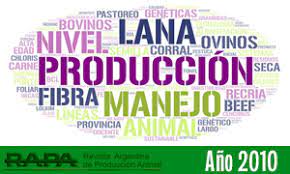Ver ítem
- xmlui.general.dspace_homeCentros Regionales y EEAsCentro Regional Buenos Aires NorteEEA General VillegasArtículos científicosxmlui.ArtifactBrowser.ItemViewer.trail
- Inicio
- Centros Regionales y EEAs
- Centro Regional Buenos Aires Norte
- EEA General Villegas
- Artículos científicos
- Ver ítem
El nivel de engrasamiento inicial y la ganancia de peso durante la recría a corral afectan los resultados físicos y económicos del proceso de invernada
Resumen
La recría de terneros a corral es una estrategia que se ha incorporado a los sistemas de producción en los últimos seis o siete años. El manejo durante la fase de recría a corral puede afectar el resultado físico de todo el proceso de invernada. El objetivo de este trabajo fue evaluar el efecto del nivel de engrasamiento inicial y la ganancia de peso (GDP) durante la recría a corral sobre los resultados físicos y económicos del ciclo total de invernada:
[ver mas...]
La recría de terneros a corral es una estrategia que se ha incorporado a los sistemas de producción en los últimos seis o siete años. El manejo durante la fase de recría a corral puede afectar el resultado físico de todo el proceso de invernada. El objetivo de este trabajo fue evaluar el efecto del nivel de engrasamiento inicial y la ganancia de peso (GDP) durante la recría a corral sobre los resultados físicos y económicos del ciclo total de invernada: recría a corral, engorde a pasto y terminación a pasto o a corral. Se utilizaron terneros británicos de menor (Men) y mayor (May) nivel de engrasamiento y peso inicial. Las GDP objetivo en cada grupo fueron: Rápida (R), Intermedia (I) y Lenta (L). Durante la etapa de recría a corral los terneros Men consumieron menos kilos de alimento y fueron más eficientes en convertir ese alimento en carne. El menor nivel de engrasamiento al ingresar al corral y una GDP I o L durante la recría determinaron un menor nivel de engrasamiento a la salida del corral de recría y esto resultó en una mayor GDP y en una mayor producción por animal durante la fase subsiguiente de engorde a pasto. Asimismo, esa combinación permitió reducir el peso medio y por lo tanto incrementar la carga del sistema, afectando positivamente la producción por unidad de superficie. A su vez, el ingreso de categorías menos engrasadas y livianas redujo significativamente el monto de las compras, siendo éste uno de los rubros más representativos de los gastos directos. La mejor performance productiva durante las etapas de recría a corral y engorde a pasto de los terneros MenI y MenL permitió obtener el mejor resultado económico, a pesar de que una mayor proporción de estos animales debió ser encerrada a corral para lograr las condiciones de terminación.
[Cerrar]
In Argentina, backgrounding calves in pens is a practice that has been used in beef production systems during the last six or seven years. Management practices during this pen growing period can affect the results of the whole wintering process. The objective of this study was to evaluate
the effect of initial backfat depth and average daily weight gain (ADG) during a pen growing period on technical and economic results of the whole wintering process: a
[ver mas...]
In Argentina, backgrounding calves in pens is a practice that has been used in beef production systems during the last six or seven years. Management practices during this pen growing period can affect the results of the whole wintering process. The objective of this study was to evaluate
the effect of initial backfat depth and average daily weight gain (ADG) during a pen growing period on technical and economic results of the whole wintering process: a growing period in pen, a fattening period on pasture and a finishing period on pasture or in pen. British calves with lower (Men) or higher (May) initial backfat depth and weight were used. Predicted ADGs in each group were: Fast (R), Intermediate (I) and Slow (L). Men calves consumed less feed and were more efficient in turning this feed into gain. Lower initial backfat depth and I or L ADG during the pen
growing period resulted in lower backfat depth at the end of the pen growing period, thus resulting in higher ADG and individual production during the following grazing stage. In addition, this management led to a lower average body weight. This resulted in a higher stocking rate and, as a consequence, animal production per hectare was increased. Besides, entering a lighter (and thinner) calve to the system implied a lower amount of kilograms to be bought, that being one of the most significant component of the cots. The best performance of MenI and MenL during the pen growing period and the grazing phase allowed to obtain the best economic result, in spite of
the fact that a higher proportion of animals in these treatments was finished in a feedlot.
[Cerrar]

Autor
Ceconi, Irene;
Davies, Patricio;
Mendez, Daniel Gustavo;
Elizalde, Juan Carlos;
Buffarini, Miguel Angel;
Fuente
Revista Argentina de Producción Animal 30 (1) : 51-68 (2010)
Fecha
2010
Editorial
Asociación Argentina de Producción Animal
ISSN
0326-0550
2314-324X
2314-324X
Formato
pdf
Tipo de documento
artículo
Palabras Claves
Derechos de acceso
Abierto
 Excepto donde se diga explicitamente, este item se publica bajo la siguiente descripción: Creative Commons Attribution-NonCommercial-ShareAlike 2.5 Unported (CC BY-NC-SA 2.5)
Excepto donde se diga explicitamente, este item se publica bajo la siguiente descripción: Creative Commons Attribution-NonCommercial-ShareAlike 2.5 Unported (CC BY-NC-SA 2.5)


